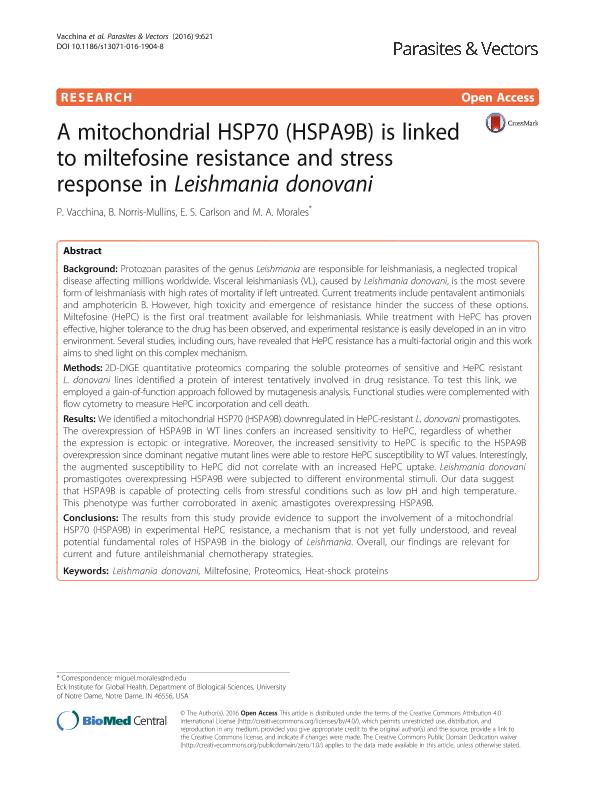Mostrar el registro sencillo del ítem
dc.contributor.author
Vacchina, Paola

dc.contributor.author
Norris Mullins B.
dc.contributor.author
Carlson, E. S.
dc.contributor.author
Morales, M. A.
dc.date.available
2018-07-23T17:01:41Z
dc.date.issued
2016-12
dc.identifier.citation
Vacchina, Paola; Norris Mullins B.; Carlson, E. S.; Morales, M. A.; A mitochondrial HSP70 (HSPA9B) is linked to miltefosine resistance and stress response in Leishmania donovani; BioMed Central; Parasites and Vectors; 9; 1; 12-2016; 1-15
dc.identifier.issn
1756-3305
dc.identifier.uri
http://hdl.handle.net/11336/52820
dc.description.abstract
Background: Protozoan parasites of the genus Leishmania are responsible for leishmaniasis, a neglected tropical disease affecting millions worldwide. Visceral leishmaniasis (VL), caused by Leishmania donovani, is the most severe form of leishmaniasis with high rates of mortality if left untreated. Current treatments include pentavalent antimonials and amphotericin B. However, high toxicity and emergence of resistance hinder the success of these options. Miltefosine (HePC) is the first oral treatment available for leishmaniasis. While treatment with HePC has proven effective, higher tolerance to the drug has been observed, and experimental resistance is easily developed in an in vitro environment. Several studies, including ours, have revealed that HePC resistance has a multi-factorial origin and this work aims to shed light on this complex mechanism. Methods: 2D-DIGE quantitative proteomics comparing the soluble proteomes of sensitive and HePC resistant L. donovani lines identified a protein of interest tentatively involved in drug resistance. To test this link, we employed a gain-of-function approach followed by mutagenesis analysis. Functional studies were complemented with flow cytometry to measure HePC incorporation and cell death. Results: We identified a mitochondrial HSP70 (HSPA9B) downregulated in HePC-resistant L. donovani promastigotes. The overexpression of HSPA9B in WT lines confers an increased sensitivity to HePC, regardless of whether the expression is ectopic or integrative. Moreover, the increased sensitivity to HePC is specific to the HSPA9B overexpression since dominant negative mutant lines were able to restore HePC susceptibility to WT values. Interestingly, the augmented susceptibility to HePC did not correlate with an increased HePC uptake. Leishmania donovani promastigotes overexpressing HSPA9B were subjected to different environmental stimuli. Our data suggest that HSPA9B is capable of protecting cells from stressful conditions such as low pH and high temperature. This phenotype was further corroborated in axenic amastigotes overexpressing HSPA9B. Conclusions: The results from this study provide evidence to support the involvement of a mitochondrial HSP70 (HSPA9B) in experimental HePC resistance, a mechanism that is not yet fully understood, and reveal potential fundamental roles of HSPA9B in the biology of Leishmania. Overall, our findings are relevant for current and future antileishmanial chemotherapy strategies.
dc.format
application/pdf
dc.language.iso
eng
dc.publisher
BioMed Central

dc.rights
info:eu-repo/semantics/openAccess
dc.rights.uri
https://creativecommons.org/licenses/by/2.5/ar/
dc.subject
Heat-Shock Proteins
dc.subject
Leishmania Donovani
dc.subject
Miltefosine
dc.subject
Proteomics
dc.subject.classification
Otras Ciencias Biológicas

dc.subject.classification
Ciencias Biológicas

dc.subject.classification
CIENCIAS NATURALES Y EXACTAS

dc.title
A mitochondrial HSP70 (HSPA9B) is linked to miltefosine resistance and stress response in Leishmania donovani
dc.type
info:eu-repo/semantics/article
dc.type
info:ar-repo/semantics/artículo
dc.type
info:eu-repo/semantics/publishedVersion
dc.date.updated
2018-07-23T12:55:38Z
dc.journal.volume
9
dc.journal.number
1
dc.journal.pagination
1-15
dc.journal.pais
Reino Unido

dc.journal.ciudad
Londres
dc.description.fil
Fil: Vacchina, Paola. Consejo Nacional de Investigaciones Científicas y Técnicas. Centro Científico Tecnológico Conicet - Rosario. Instituto de Biología Molecular y Celular de Rosario. Universidad Nacional de Rosario. Facultad de Ciencias Bioquímicas y Farmacéuticas. Instituto de Biología Molecular y Celular de Rosario; Argentina. University of Notre Dame; Estados Unidos
dc.description.fil
Fil: Norris Mullins B.. University of Notre Dame; Estados Unidos
dc.description.fil
Fil: Carlson, E. S.. University of Notre Dame; Estados Unidos
dc.description.fil
Fil: Morales, M. A.. University of Notre Dame; Estados Unidos
dc.journal.title
Parasites and Vectors

dc.relation.alternativeid
info:eu-repo/semantics/altIdentifier/doi/http://dx.doi.org/10.1186/s13071-016-1904-8
dc.relation.alternativeid
info:eu-repo/semantics/altIdentifier/url/https://parasitesandvectors.biomedcentral.com/articles/10.1186/s13071-016-1904-8
dc.relation.alternativeid
info:eu-repo/semantics/altIdentifier/url/https://www.ncbi.nlm.nih.gov/pmc/articles/PMC5133764/
Archivos asociados
